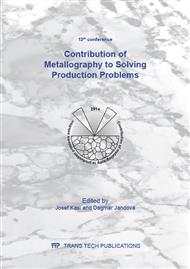[1]
D. Vollath, Nanoparticles – Nanocomposites, Nanomaterials: An Introduction for Beginners Wiley-VCH Verlag GmbH, Germany, 2013, Chapter 3.
Google Scholar
[2]
Adlim, Preparations and application of metal nanoparticles. Indo. J. Chem 6 (1) (2006) 1-10.
Google Scholar
[3]
D. Vojtech, Study of nano-crystalline metals prepared by selective chemical leaching, Manufacturing technology 12, (2012) 292-296.
DOI: 10.21062/ujep/x.2012/a/1213-2489/mt/12/2/292
Google Scholar
[4]
S. Rusz et al., Increase of efficiency of the ECAP technology at grain refinement of the alloy AlMn1Cu. Archives of Materials Science and Engineering 34 (1) (2008) 52-56.
Google Scholar
[5]
Information on http: /en. wikipedia. org/wiki/Severe_plastic_deformation (31/08/2013).
Google Scholar
[6]
D. Vojtěch, Prášková metalurgie jako metoda zpracování hliníkových odpadů s vysokými obsahy železa, Strojírenská technologie 17, (2012) 127-132 (in Czech).
Google Scholar
[7]
A. Inoue, A. Takeuchi, Recent progress in bulk glassy, nanoquasicrystalline and nanocrystalline alloys, Materials Science and Engineering A 375 – 377(2004) 16–30.
DOI: 10.1016/j.msea.2003.10.159
Google Scholar
[8]
M. Galano et al., Nanoquasicrystalline Al–Fe–Cr-based alloys with high strength at elevated temperature, Journal of Alloys and Compounds 495 (2010) 372–376.
DOI: 10.1016/j.jallcom.2009.10.208
Google Scholar
[9]
A. Michalcová et al., Structure and mechanical properties of AlCr6Fe2Ti1 alloy produced by rapid solidification powder metallurgy method, International Journal of Materials Research 101 (2) (2010) 307-309.
DOI: 10.3139/146.110274
Google Scholar
[10]
K. Tapan et al., Complex-Shaped Metal Nanoparticles, Wiley-Verlag, 1. Edition, Weinheim, Germany, (2012).
Google Scholar
[11]
A.R. Tao et al., Shape Control of Colloidal Metal Nanocrystals. Small 4, (2008). p.310 – 325.
Google Scholar
[12]
P. Zhenmeng et al., Designer platinum nanoparticles: Control of shape, composition in alloy, nanostructure and electrocatalytic property, NanoToday 4 (2009) 143–164.
DOI: 10.1016/j.nantod.2008.10.010
Google Scholar
[13]
R. Sardar et al., Gold nanoparticles: Past, present, and future, Langmuir 25 (2009) 13840-13851.
DOI: 10.1021/la9019475
Google Scholar
[14]
Information on http: /water. usgs. gov/wrri/08grants/progress/2008RI75B. pdf (21/06/2012).
Google Scholar
[15]
M. Tokita, Spark Plasma Sintering (SPS) Method, Systems, and Applications. Handbook of Advanced Ceramics, 2nd ed., Academic Press: Oxford, 2013, Chapter 11. 2. 3, p.1149–1177.
DOI: 10.1016/b978-0-12-385469-8.00060-5
Google Scholar
[16]
Z. A. Munir, U. Anselmi-Tamburini, M. Ohyanagi, The effect of electric field and pressure on the synthesis and consolidation of materials: A review of the spark plasma sintering method, Journal of Materials Science 41 (3) (2006), 763-777.
DOI: 10.1007/s10853-006-6555-2
Google Scholar
[17]
G.F. Taylor, Apparatus for making hard metal compositions US Patent 1, 896, 854 (1993).
Google Scholar
[18]
K. Inoue, Electric discharge sintering US Patent 3, 241, 956 (1966).
Google Scholar
[19]
M. Tokita, Trends in advanced SPS spark plasma sintering systems and technology, Journal of the Society of Powder Technology 30 (11) (1993) 790-804.
Google Scholar


